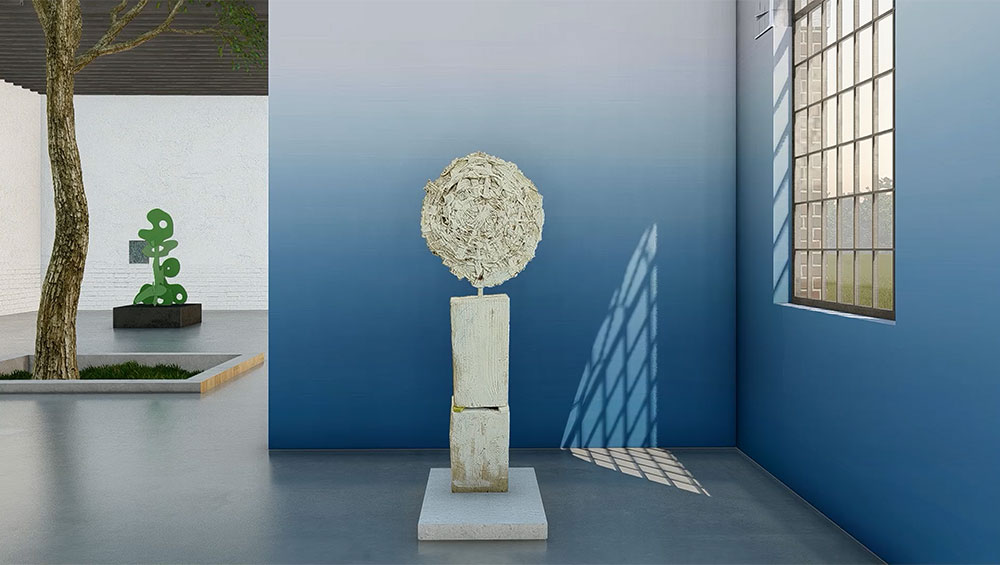
Her Dark Materials, screenshot, Eye of the Huntress, 22 June – 22 September 2021.
Online at Eye of the Huntress
22 June – 22 September 2021
by ANNA McNAY
Eye of the Huntress is a new initiative created by Alexandra Ray and Catherine Loewe, two art lovers with longstanding experience of collecting, advising and curating, who, despite being based on either side of the Atlantic, have combined their talents to launch an alternative way of viewing and buying art. Partly in response to the pandemic, and their belief that collectors currently have the focus to seek out new work for their homes, they are embracing the latest digital technology to present quarterly curated virtual exhibitions, not set in a white-cube “gallery”, but, each time, in a different architectural location around the world. Their belief is that, with so many online offerings, the key is not only in the concept of the curation, but in making the offering “digestible” and “bite-sized”.
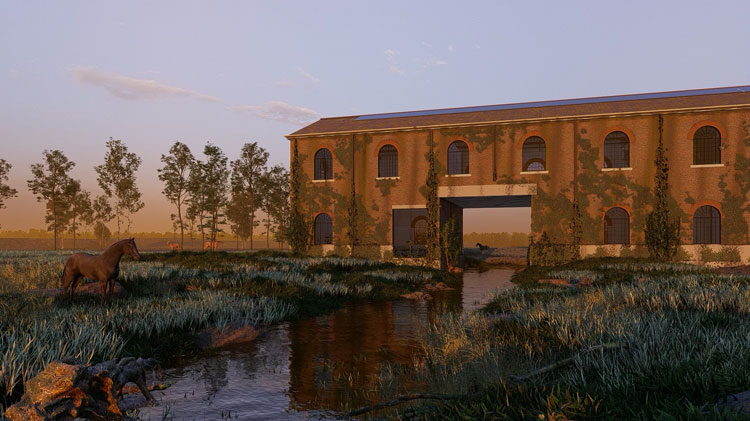
Her Dark Materials, screenshot, Eye of the Huntress, 22 June – 22 September 2021.
Accordingly, the inaugural exhibition, Her Dark Materials, curated by Philippa Adams (a former director and head curator of Saatchi Gallery’s collection), brings together works by an international group of 27 female artists – some better-known than others – interweaving sculpture, tapestry, collage, painting, photography and more. What all the artists and works have in common, however, is a desire to delve deep into the psychological, political and cultural issues faced by women today.
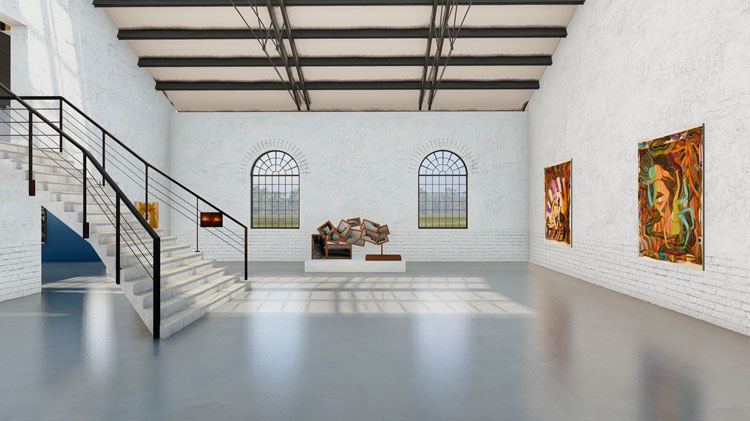
Her Dark Materials, screenshot, Eye of the Huntress, 22 June – 22 September 2021.
The “venue” for Her Dark Materials (beyond your living room, that is) is a digital rendering of a former industrial warehouse that formed part of Wolverton Railway Works. Built in 1838, the building was left to decay, but is brought to life here by the visionaries at the virtual experience design studio INVI and the building survey drawings and conversion design of architects Julyan Wickham and Alex Bilton. It certainly works as an alluring space – perhaps not one that would help me envisage the works on display hanging on my own walls, but, when it comes to rich collectors, who knows (think vast loft conversions in east London or New York City, for example)?
Aside from the video tour (which, at four and a half minutes, moves past the works far too quickly for my liking, forcing me to pause and rewind continually), there is a plethora of information on the website, explaining the concept of Eye of the Huntress, and also providing links to each artist in the current exhibition, as well as to each work, naturally with full details, including titles, mediums, dimensions, and, of course, price (in dollars and pounds) – oh, and that all-important “call-to-action” button: “inquire”.
In many ways, scrolling through each artwork one-by-one makes for better viewing than the tour – rather like self-guiding yourself around an exhibition, stopping for as long as you want in front of works that enthral you, and zipping past those that leave you cold, as opposed to taking a curator’s tour, where you are forced to go at their speed, and receive information on what they deem relevant, not what whets your particular appetite. Nevertheless, seeing the works displayed in succession is – even for an anti-virtual-art-experience luddite like me, interesting, if only for the conversations it initiates, or highlights, between artists and works.
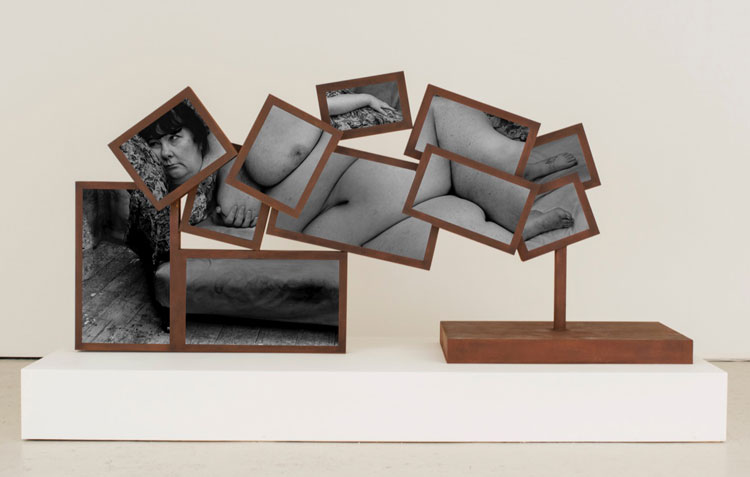
Charlotte Colbert. Benefit Supervisor Sleeping, 2017. Corten steel structure, TV screens displaying moving image, W:265.4cm H:132cm D:80cm. Copyright the artist.
For example, Charlotte Colbert’s broken-up, collaged TV screens of parts of a nude female body, jumbled together to make a near whole, relate to art history in a couple of ways – through the work’s title, Benefit Supervisor Sleeping (2017), clearly to Lucian Freud, but, through its concept, to John Coplans.
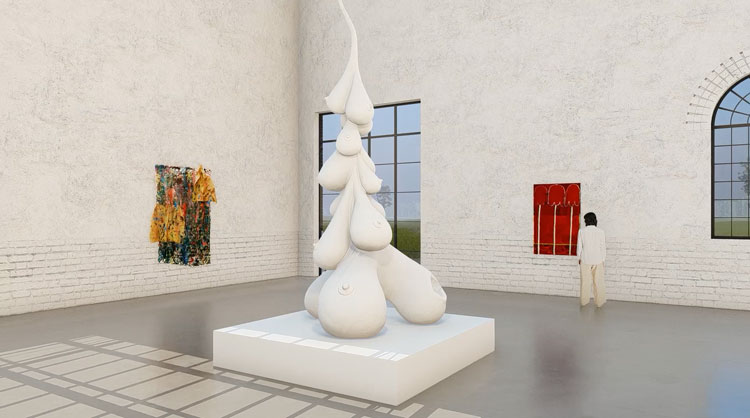
Charlotte Colbert. Mastectomy Mammeria, 2019. Foam and plaster, H:290cm x W:130cm x D:130cm. Her Dark Materials, screenshot, Eye of the Huntress, 22 June – 22 September 2021.
There are, however, also conversations within the exhibition between Colbert’s work – including her foam and plaster sculptural mountain of drooping and dripping breasts, Mastectomy Mammeria (2019), as well – and the abstract, steel Sedna Sculptures (2021) and Bonobo (2021) by Misha Milovanovich, which call to mind equally shapely female forms. Of course, without further information, one doesn’t know whether Colbert’s sculptural piece might not be an homage to a lost body part – and, with it, a lost sense of femininity – which could also explain her wish to break the body down into metonymic parts.
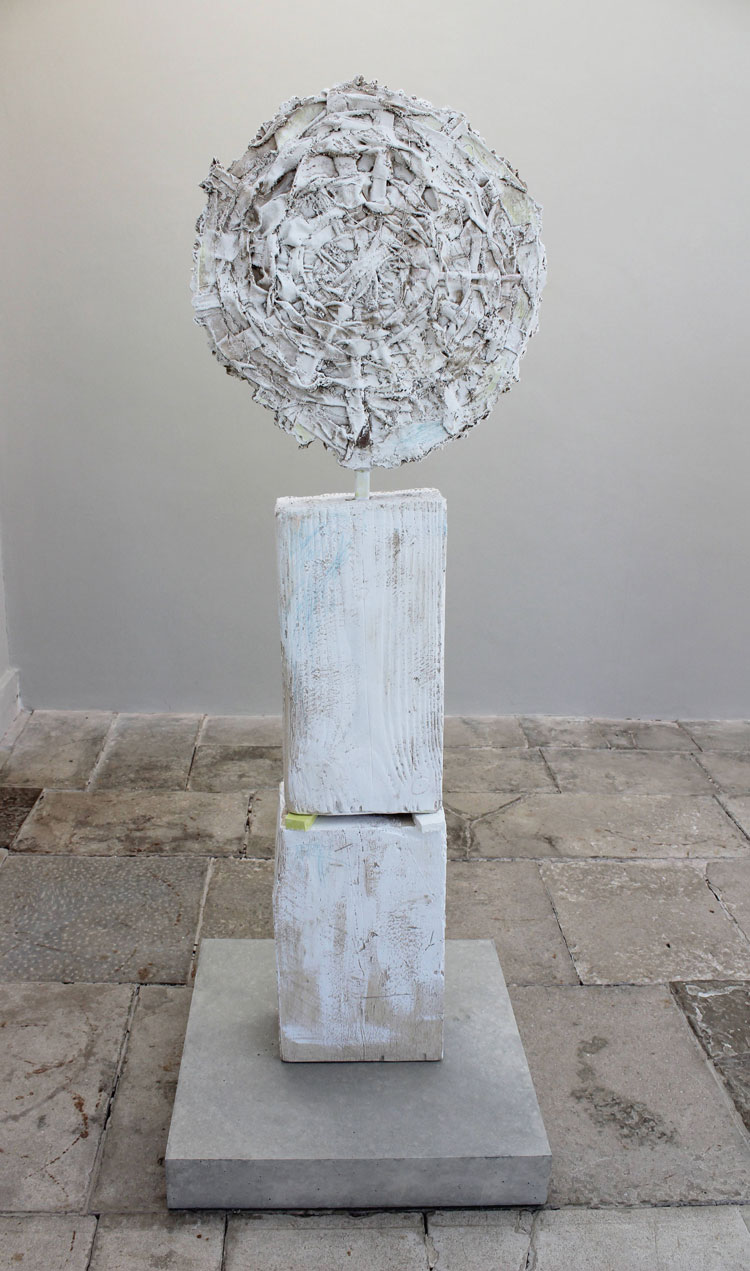
Jodie Carey. Sun Disc I, 2020. Colouring pencil, paint, earth, plaster, wooden shims, steel and concrete, 212 x 70 x 70cm. Copyright the artist.
Jodie Carey’s sculptures, Sun Discs I – III (all 2020), with their interwoven meshes of wooden shims, steel and concrete, in turn, speak to Alice Anderson’s – in this instance “flat” – wrapping up of, presumably, a canvas, with copper-coloured aluminium wire, Body Itineraries #17 (2019), where, in both instances, there is a sense of seeking to protect, hold in, conceal and console.
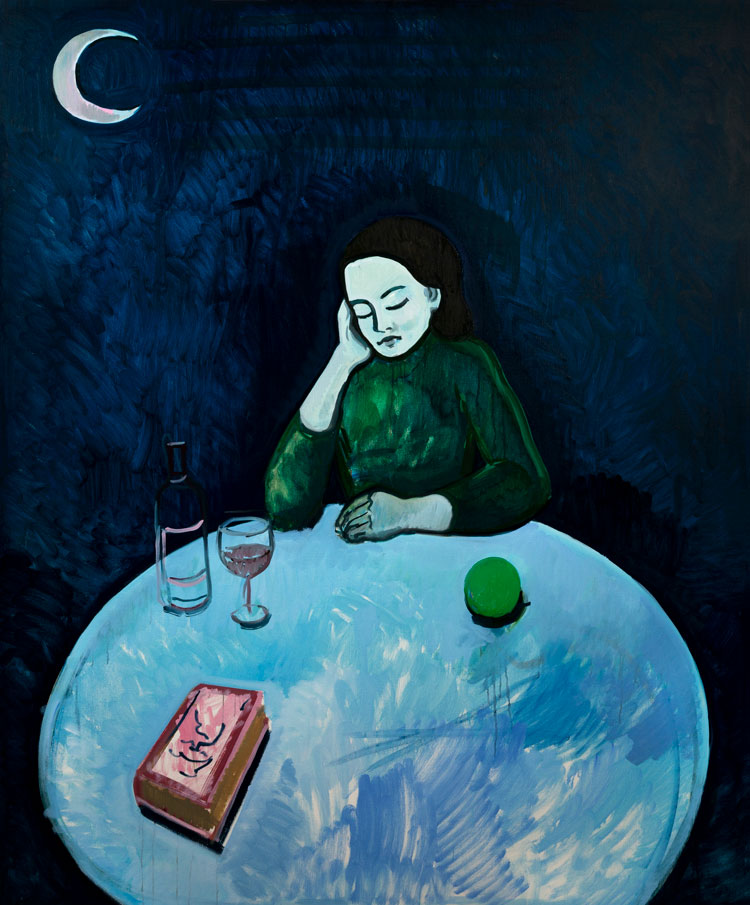
Nancy Cadogan. Under The Crescent Moon, 2021. Oil on canvas, 180 x 150 cm. Copyright the artist.
Nancy Cadogan’s muted painting, Under the Crescent Moon (2021), depicting a woman, head supported on hand and eyes closed, alone at a round, white table – the full moon beneath the crescent – with a bottle of red wine, a book (albeit out of reach) and a green sphere (a ball? An apple?), captures a melancholia still known by so many women today (it was not just a thing of the 1950s). Perhaps that exhausted moment at the end of the day when the children are finally in bed? Perhaps that lonely hour, when she realises she is alone and not entirely satisfied with her lot? Certainly, that moment of unmasking after the public face – and obligatory smile – has been upheld throughout the day. Here, the passive (moonlit) side of her personality is free to shine through – or, scientifically correctly speaking, reflect (a further metaphor for what the woman herself seems to be doing). Sahara Longe’s full-length Self-Portrait (2021), hands clasped, eyes not quite meeting the viewer’s gaze, might carry a similar sentiment.
.jpg)
Sahara Longe. Self Portrait, 2021. Oil on jute, 215 x 100 cm. Copyright the artist.
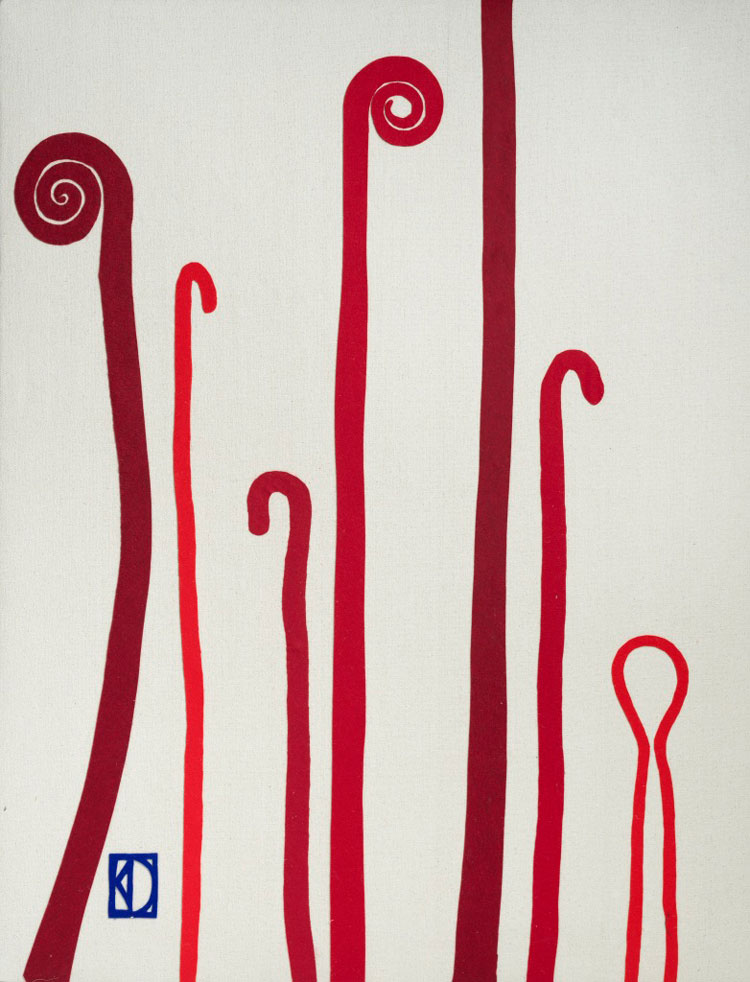
Kate Daudy. Mummification Tools, 2019. Wool felt decoupage on canvas, 132 x 178 cm
Several of the artists reference growth and expansion – the opposite, then, of Carey and Anderson – through imagery of shoots and simple frond-like shapes. Kate Daudy, for example, with her decoupage Mummification Tools (2019) (her neighbouring piece, entitled Growth, also 2019, incorporates the word itself); Galina Munroe’s Crimson Caps (2021); and Florence Hutchings, with her painting Tulips from Amsterdam (2021), which, along with her two further pieces, also recalls the domestic scenes of Mary Fedden.
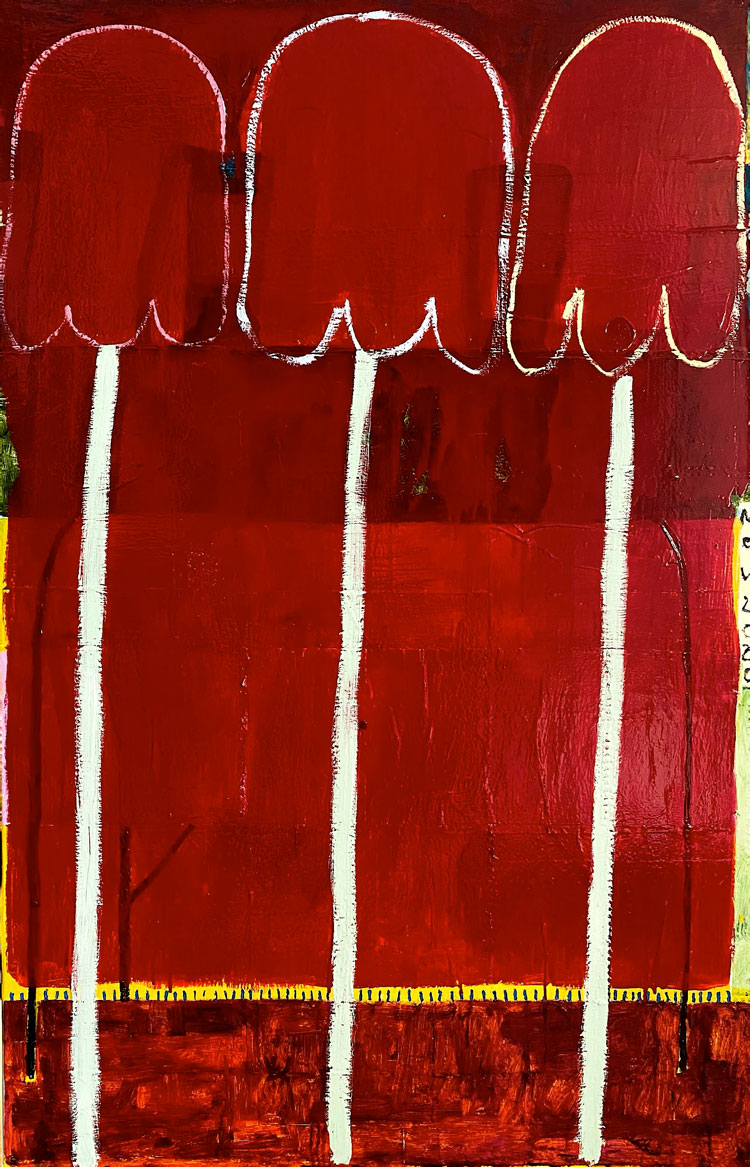
Galina Munroe. Crimson Caps, 2021. Oil, gloss paint and collage on canvas, 140 x 90 cm. Copyright the artist.
Noémie Goudal’s photographic fronds are much wilder and speak, it seems, of a different era – not that there is a noticeable age gap between the artists themselves.
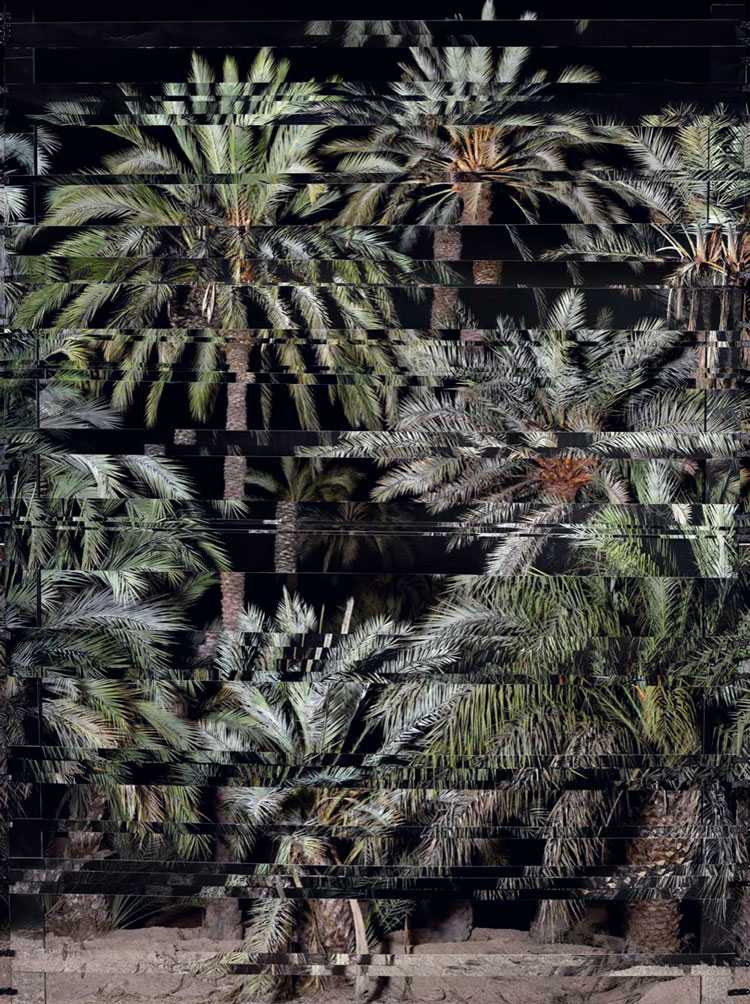
Noemie Goudal. Les Mecaniques - Phoenix Atlantica III, 2021. C-print, 200 cm x 149 cm. Copyright the artist.
Spirituality pervades the exhibition, with Emma Talbot’s three colourful acrylic paintings having something of a sense of Hilma af Klint, while Kirstine Roepstorff’s three monochromatic pieces pare things down to basics: a circle, a triangle, some blocks.
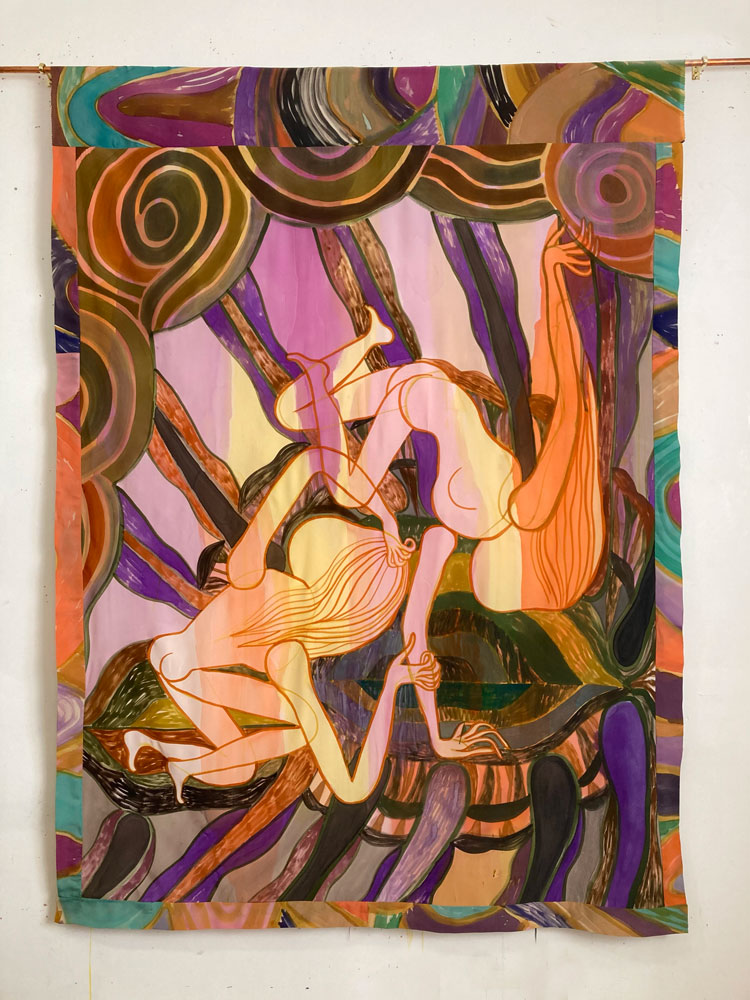
Emma Talbot. Dream Catcher, Acrylic on pink crepe de chine silk, 206 x 147 cm. Copyright the artist.
There are so many more artists who deserve an individual mention, but to roll call all 27 would be superfluous. All I can really shout as loudly as possible is how successful the curatorial and paring-down process of this exhibition have been. The evident careful consideration has enabled these many messages, and aspects of femininity and womanhood, to shine through, and these dialogues – both between works in the exhibition, and with art history – to arise. This is not something one would normally expect from a site intended primarily to sell.
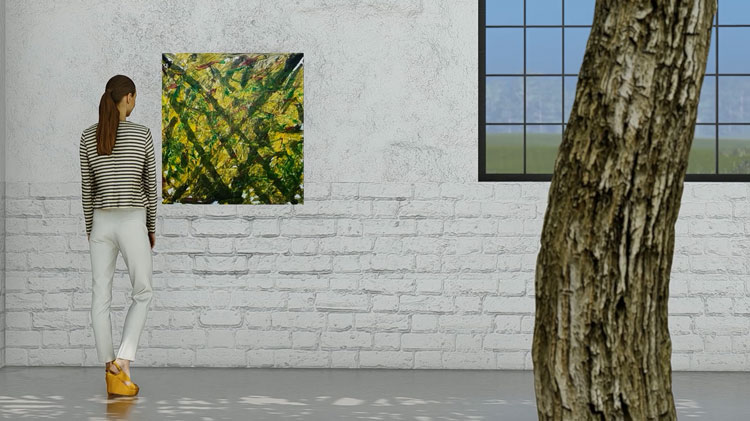
Her Dark Materials, screenshot, Eye of the Huntress, 22 June – 22 September 2021.
As well as the virtual tour, there is a section on the website with installation views – basically stills from the film, in the order they occur – which can provide that slower meander, following the curator’s speedy dash. What is missing from both, however, is the information on the artists and works, although that is only ever a click away, and, indeed, hypocritically, how often have I complained that visitors only ever wander through galleries and museums looking at the information boards and using their phones to photograph the work, without even really looking, except through their tiny screen, before moving hastily on? I guess I’m coming at this from a critic’s angle, eager to find the information I need to write this review. But for the collector, the art aficionado, or even just the layperson who has stumbled on or been recommended this site: Hurrah! Finally, an opportunity to be led by their eyes, their heart and their gut – and then, and only then, to seek out the available information for the head.
I have to commend everyone involved in setting up this initiative, for it may even have persuaded me to come back again to the next virtual offering – and that, believe me, is the highest praise I can give. The careful and thoughtful “editing” or curating, the brilliant selection of artists, and the clear and concise website – even without the clever techie digital architectural rendering part – are an outright win. Well done!